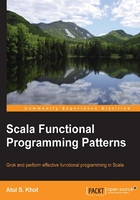
Chapter 1. Grokking the Functional Way
Before we start learning Scala, let's first understand what functional programming (FP) is. You may have used a spreadsheet while working. In a spreadsheet, there is a bunch of equations and we enter values in the given cells for these equations. We get the answers through these equations. When you enter the same values again, you get the same answer and there are no fallouts.
At the core of FP is composition. Looking at a software system made up of parts, we build bigger parts by composing smaller parts. If you think about it, most complex systems are composed of parts, which in turn are composed of smaller parts. Functional languages give us the means to make this composition. One of the prominent functional languages that can be used for FP is Scala.
Scala in Italian means a staircase. If you look at the language's logo, you will see it's a staircase. The language acts as a staircase through which we can ascend and become better at programming. Scala also refers to the very many techniques that we can use to control the complexity of large-scale systems.
We will begin to learn Scala by looking at abstractions. We will see why abstractions are good and how Scala helps us to be abstract. Scala code is concise and expressive. A lot of the concise expression is due to functions. Functions are an important pillar of functional programming. In this chapter, we will look at pure and impure functions. Reducing the number of moving parts to be used is an effective technique to control programming complexity. Immutability is another pillar of FP that helps us here. To see all this in effect, we will take a problem example and implement the solution in Java. Then, we will solve the problem using Scala. Looking at a few Scala one-liners will help us to get started with READ/EVALUATE/PRINT LOOP (REPL). We will use Scala REPL extensively throughout the entire book.
Finally, we will look at idioms and patterns. Traditional patterns in Scala look very different from their Java counterparts. We will briefly look at the command and strategy of Scala and see how functions are used to pass algorithms around.
Welcome to the Scala fun ride!